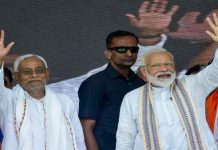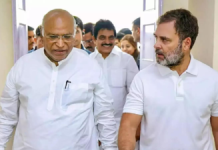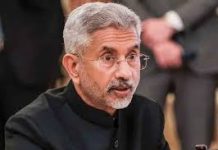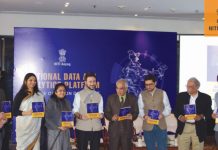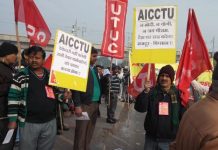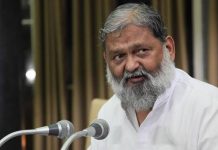
The Country is waiting for China and Pakistan to take sides in the Afghanistan turmoil, writes Gopal Misra
China is hesitant as Pakistan indulges in its old rhetoric of running with the hare and hunting with the hound. However, India maintains her commitment to the present Kabul government; a continuation of the Northern Alliance years.
India was an active participant of the Northern Alliance following the exit of USSR from Afghanistan during the nineties, suffered the Jihadis and even the Indian civilian plane was hijacked to Kandhar. India not harbour any “ill-will” against the Taliban, but they have to support a neutral country distancing itself from the terrorists’ nurseries in Pakistan.
The battle-lines are being drawn in the war-ravaged Afghanistan. In spite of the recent despatch of the 10,000 Jihadis, trained in Pakistan, the Kabul government’ troops have not only successfully wiped out most of these “agents” of the Pakistani army, but even in certain key battles, the Afghan Taliban have been trounced. It has convinced that New Delhi that the Ashraf Ghani and Abdullah government in Kabul needs full Indian support and the Taliban forces are not as invincible as being much-trumpeted.
Meanwhile, Taliban has repeatedly made it clear that it has nothing to do with Pakistan’s Kashmir agenda, it has never really refused to provide safe havens to Kashmir-focussed Jihadist-terror groups like Lashkar-e-Taiba (LeT) and Jaish-e-Mohammed (J-e-M), but its proximity with Pakistan is worrisome to the policymakers at the South Block.
Meanwhile, India has refused to accept the “so-called” differences between General Qamar Javed Bajwa’ the present army chief of Pakistan and Prime Minister Imran Khan, which Bajwa favours a “constructive approach” towards the reconciliation between the Afghan Taliban and the Afghanistan government. The ground realities, however, betray the real agenda of the Pakistan army and its intelligence wing, Inter-Services Intelligence (ISI). Khan’s tilt towards radical Islam is part of the well-conceived strategy of the ISI and its proxies. Earlier, it used to receive liberal funding from the US-led West to oust the USSR from Afghanistan; and later it again received huge financial support in the name of the “war against terrorism”.
It is getting much more difficult for the Taliban to sustain its initial victories against the government forces in the coming months. With the renewed confidence following India’s support both in the terms of financial and strategic and her diplomatic offensive, the Kabul government has refused to be cowed down. Amidst the reports that India is pouring in a massive dose of defence equipment to serve the Afghan forces, India’s foreign minister, Jai Shankar spells out the Indian roadmap for peace in the war-ravaged country. He told the Shanghai Cooperation Organization (SCO) recently held at Dushanbe, Tajikistan, that the only solution is to resolve the vexed Afghan issue is “negotiations”. It was attended by the foreign ministers of China, Kazakhstan, the Kyrgyz Republic, Pakistan, Russia, Tajikistan and Uzbekistan.
China had remained non-committal during the SCO meet. It was not surprising because during the past few months, a number of Taliban representatives had already visited China. They reportedly had assured that China could go ahead with its ambitious mining projects in Afghanistan. During this high-profile meeting, the Chinese foreign minister, Wang Yi, appeared to be more confidant with an assurance already obtained that the Afghan Taliban would not further radicalise the Uyghuy Muslims of the neighbouring Xinjiang province of China.
The Chinese province borders with Afghanistan. Thus, the exit of America after a 20-year war has brought this wonderful land to precipice; the greedy eyes of Dragon exploit its minerals estimated to be of more than three trillion USD by the contemporary market rates.
However, amidst these discussions for peace, the Chinese delegation at the SCO was reportedly shocked, when it learned about the bomb blast in a bus carrying 31 Chinese engineers to the site of a hydro-electric station on the north-western region of Pakistan killed 13 Chinese engineers on the spot and many others seriously wounded. While China has called it a bomb attack, Pakistani authorities claimed that it was a mechanical failure caused a gas leak which led to the explosion.
The Khyber Pakhtunkhwa’s Inspector General Moazzam Jah Ansari, however, has told media, “Looks like sabotage.” Earlier, this month China already has already evacuated 210 engineers and workers from the region. The violence may force China to work for peace, if it really wants to access Afghanistan’s unexploited reserves of copper, coal, iron, gas, cobalt, mercury, gold, lithium and thorium.

It is now for Wang Yi to trust Taliban’s one of the spokesmen, Suhail Shaheen, or genuinely work for peace. Shaheen, who had been to Beijing several times recently told in an interview to the South China Post that his organization considers China as a “friend” to Afghanistan, and would guarantee the safety of Chinese investors and workers, and Taliban would not host Uyghur militants from the Xinjiang province.
Pakistan’s agenda to repeat its “radical Islam” too has suffered with the arrival of hundreds of bodies brought to the border areas of the fighters it had sent. Earlier, the Afghan forces used to arrest them and most of them were given back to Pakistani authorities at the border.
However, with the cold-blooded murder 16 Afghan soldiers at the Salma Dam in western Herat province in the western Afghanistan, who had surrendered on July 6 this year, has convinced the Kabul government to kill the Taliban forces. The dam and its adjoining hydro-electric power station, which had been set up with the Indian assistance was renamed as the Afghan-India Friendship dam. It is believed that those who killed the soldiers and damaged the dam were trained in Pakistan.
Earlier, in the Taliban attack on the Kabul gurdwara, Taliban had promptly told India that the attack was done by the ISI-sponsored terrorist group, and also had traced the ISI proxy, an Indian Malyali Muslim recruited for the purpose, who was later handed over to the Afghan government.
There were two distinct groups within the SCO, the first led by India and Russia keen to strive for a “peaceful negotiations” to end the ongoing fratricide in the country, and the other comprised Pakistan and China, who were much more concerned about the Indian and USSR assistance to the Kabul government. For India and Russia anything was acceptable, but it must prevent the further radicalization of Islam in the Central Asian and in its pre-dominant Muslim province of Chechnya in the North Caucasus region.
The Abduction of Ambassador’s Daughter
Within a few days of the SCO conference, Silsila, the winsome young daughter of the Afghan ambassador, Najibulah Alikhil, is abducted and later released. The kidnapping and thrashing of Silsila, has shocked India too. The New Delhi was reminded of the kidnapping of the daughter of India’s Home Minister, Mufti Mohammed Sayeed, Dr Rubaiya Sayeed in 1989. She was freed following the release of the 13 dreaded terrorists, who were functioning in the Jammu-Kashmir as Pakistan’s proxies.
The docile VP Singh’s government conceded the demand and the dreaded Jihadis were released. Singh’s cabinet colleague, Inder Kumar Gujaral, who later became prime minister and Farooq Abdulla had negotiated the deal. However, the Kabul Government refused to be cowed down by the kidnappers. She was released, but was thrashed before being released. It is yet to be seen whether the kidnappers would be arrested and brought to justice. It is unlikely, because it is a known fact that the “proxies” of ISI kidnap journalists and activists in Pakistan.

India and the Afghanistan
It is true that India is reluctant to send its troops to Afghanistan, but she would not allow her friendly democratic government in Kabul succumbs to the Pakistan-China conspiracy. The present Kabul government, though installed by the Americans, is the successor of the Northern Alliance supported political outfit. The Northern Alliance comprised Russia, China, Afghanistan and India, while the Taliban were supported and funded by USA and Pakistan for its role in ousting the USSR in Afghanistan and Central Asia.
During the brief 11-month tenure of the Gujaral government in1997-98, the support to the Northern Alliance was reduced. However, it was during the regime of Atal Bihari Vajpayee the full trotted support to the Northern Alliance was restored. The policy was continued during the UPA Government under Dr. Manmohan Singh.
The Muslim Jihadis attack on New York in 2001 brought paradigm change in the west’s perception towards Islamic terrorism. The US-led war against terrorism brought the democratic world on one platform, but Pakistan continued its ties with the Taliban; and China eyeing with the country’s mineral resources started wooing the Taliban.
Even before the US decision to leave Afghanistan, China has been dropping hints to the Afghan government that both Afghanistan and China can benefit out of enhanced cooperation; but it is also using the Pakistan axis to earn goodwill with Taliban. There are reports that China and Pakistan have started an intelligence sharing mechanism to augment Beijing’s influence in the country at the expense of the United States.
In this context, India is keen for a peaceful dialogue to end the impasse, but China and Pakistan are keen to allow the Kabul government to be overwhelmed by the Jihadis. Their agenda is clear; while China is keen to access its mineral resources, Pakistani army and its proxies are in hand and glove with the Taliban supported poppy growers and the opium processing units on the Pakistan-Afghan borders. China, which has already connived with the Myanmar army and the Pakistan’s anti-democratic establishment, dreams to use the Islamists to continue to wage “non-state proxies” against India.
During this Afghan crisis, India has never indulged in ”double-speak” like Pakistan and China, but the Chinese continue to be haunted by “The fears that the Chinese Uyghur, who are among the terrorists now, can cross the territory of China through Afghanistan and unleash unprecedented problems for it.” There are reports of the presence of the ethnic Uyghurs amongst the Taliban regime, who received good training at Al-Qaeda camps. The 76-kilometres border between China and Afghanistan on the far West could provoke militancy in China.
Contemporary Afghanistan, the melting point of different cults or shades within a faith, ethnicity and the expression of the most appreciated human behaviour, needs international initiative for the protection of its unique geographical, environmental, and the human existence threatened by the outside forces, whether it is the US-led west, the Russians and now China. Their identities could be explained in terms of their specific tribal loyalties under the overwhelming plural expression of Islam, however, both Islam, the religion which preaches “peace”, and the specific tribal loyalties have been hijacked to serve certain “power games” in the contemporary play of international politics. It is the lack of common agenda among the people of this unique nation weaved as a strong nation two centuries ago has triggered off the outgoing civil war is, perhaps, has caused its existential challenge.
It is little surprising that western scholars have been emphasising the variety of social groups, ethnicity and the differences among the various shades of Islam. They seldom discuss and care to explain that why Afghanistan has emerged as a highly accomplished nation in terms of human development or behaviour; and how its society was penetrated, Islam hijacked ending its “humane” touch to be replaced by an image of warmongers or a land of the trigger-happy warriors.
In India, the people of this region are identified as the ‘pathan’, who represents valour, uprightness and extreme loyalty. They are one of the most trusted people of the South Asian region, especially in India, where the generations continue to dream about the legendary “Kabuliwala”— the vendor from Kabul, the symbol of love and family offering dry fruits to a young girl thousands of kilometres away from his homeland in Kolkata.
The time passes, the Kabuliwala travels, but is not able to return to Kabul, however, years later, he revisits Kolkata to meet his young customer. He was expecting to meet a child girl, but finds her in a wedding dress, being married off, it suddenly dawns on him that so much time has passed, and his daughter too might have grown up too married! The human sensitivity of an unknown vendor from a far off land evokes human bonds.
In spite of the contemporary image of Afghanistan as a land of quarrelsome tribes, poppy cultivators and the trigger-happy Islamists, in India’s elephantine memory, the country still remembers her Kabuliwala.
Indian Proposal Non-Starter
It is not surprising if few appeared to be serious on India’s “peace proposals”. For them, especially in the case of China and Pakistan, why did India invest US$3 billion for the development of the country without any “perceptible return”, and again she is ready to invest in Chabahar port, where India already has pumped in billions of USD to enable Afghanistan, a land-locked country, to end its dependence on Pakistan. For many India’s initiative may have the overtones of some strategy, because they could not visualize that “India-Afghanistan” are bounded by history and culture. There are different opinions on the issue whether Pashto has descended from Avestan, the language of Parsees in India. The holy text of Zoroastrianism is written in its script.
Amidst the Dushanbe’s high-profile interactions the Afghanistan’s External Affairs Minister, Haneef Atmar, asks Jai Shankar for full military support to his country. However, much would depend upon the USA’s policies towards Iran. India’s could be an active partner if Iran and Russia join her and the US and the western powers support the proposed military intervention.
The continuous conflicts have damaged the environment of the land, which once boasted a vast array of high-quality, organic, and highly sought-after dried fruits. The selection of Afghan dried fruits includes fruits such as raisins, apricots, figs, cherries, prunes, dates, and mulberries, and the world is awaiting them. The higher steep slopes of Hindukush’s pistachio forests have been destroyed to cultivate poppy.
India has to retain her interests in Afghanistan, which is the gateway to the Central Asia and Iran for her, the tall, forbidding mountains and dry deserts cover most of the landscape of Afghanistan. Therefore, it cannot remain aloof to the developments in the region, China and China, Pakistani leadership led by Prime Minister Imran Khan had already begun praising Osama-bin-Laden, the master mind of the 2001 attack on New York and Pentagon. Only knave will believe that he is taking an independent line much to the discomfiture of Bajwa. India knows that it is a part of the ”double-speak”, refuses to take these statements seriously, and is rightly poised for the great game.
tehelkaletters@gmail.com

